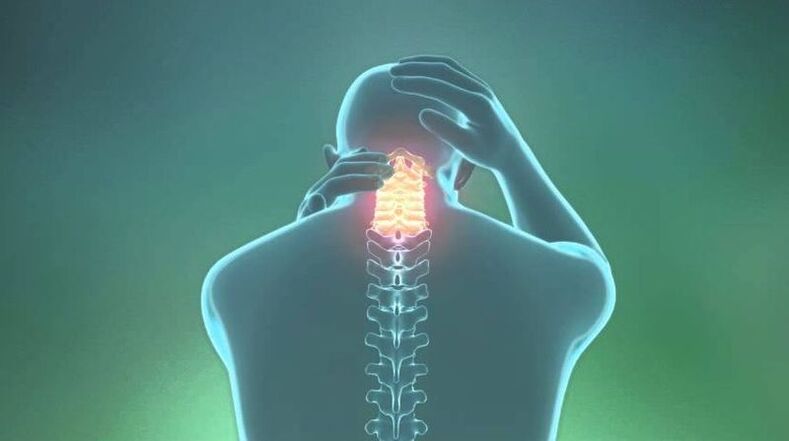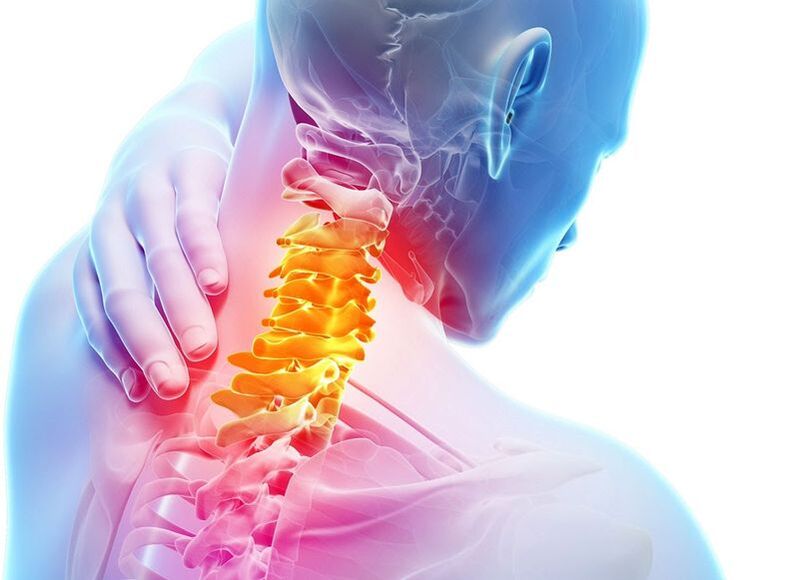Osteochondrosis of the cervical spine is the result of a sedentary lifestyle, malnutrition.The first signs of the disease may appear at 25 years old, if you do not start treatment, severe complications will occur.In the therapy of the disease, an integrated approach is used - drug treatment, diet therapy, physiotherapy and physiotherapy.

The causes of osteochondrosis of the cervical spine
Cervical osteochondrosis-degenerative-dystrophic changes in intervertebral discs, joints, which leads to a decrease in the mobility of the neck, the appearance of severe pain syndrome.The main reason for the development of the disease is a violation of mineral metabolism, due to which the bones and joints become less strong.
Why is there cervical osteochondrosis:
- overweight, sedentary lifestyle;
- violation of posture, scoliosis;
- rheumatism;
- flat feet;
- VSD;
- Improper nutrition.
Investments in the deformation of the cervical vertebrae can provoke injuries, bruises of the spine, excessive physical activity, stress.In women, osteochondrosis often occurs during pregnancy, menopause - against the background of hormonal changes, the amount of calcium decreases, bone tissue becomes fragile.
General symptoms and signs
With a constant increased load on the cervical vertebrae, muscle spasm occurs, the vessels of the cervical spine are compressed, the circulatory process is disturbed, malfunctions occur in metabolic processes - the structure of the intervertebral discs changes, they are deformed, begin to protrude beyond the spinal column.
How is osteochondrosis of the cervical region manifested:
- rook syndrome - against the background of compression of the nerve endings, pain occurs, which spreads from the neck to the shoulder blades, forearms, covers the front wall of the chest;
- muscle weakness in the hands, noticeable edema of the neck;
- When the head moves, a characteristic crunch is heard;
- weakness, chronic fatigue, blood pressure changes;
- Violation of coordination, the head often dizzy, attacks are accompanied by nausea, vomiting;
- vision of vision and hearing, noise, ringing in the ears;
- numbness of the limbs, language;
- frequent migraines;
- In women aged 45–65 years, pain appears during sleep, numbness, tingling in the upper limbs, attacks can be repeated several times a night.
With cervical osteochondrosis, nutrition and blood supply to the brain are disturbed, neurotic disorders occur - anxiety, irritability, mood swings, sleep disturbance.
Classification of cervical osteochondrosis
As osteochondrosis develops, several stages of development pass, each of which has characteristic features.What the affected spine at different stages looks like, you can see in the photo.
The degree of development of the disease:
- Osteochondrosis of the 1st degree - the initial stage proceeds without particularly pronounced symptoms, a person is concerned about rare and minor pains when turning and tilting the head, the back muscles quickly get tired.
- Osteochondrosis of the 2nd degree - the vertebrae become unstable, pinched the nerve, unpleasant sensations in the neck acquire a pronounced character, gives it to the shoulder, hand.Additional symptoms are increased fatigue, frequent headaches in the occipital region, distraction.
- Osteochondrosis of the 3rd degree - pain acquires a chronic character, covers the upper back, arms, pronounced muscle weakness is observed, limbs are numb, intervertebral hernia develops, and dizziness often occurs.
- Osteochondrosis of the 4th degree - there is a complete destruction of the intervertebral discs, they are replaced by connective tissue, the pathological process covers several segments of the spine.There is a violation of coordination, bouts of dizziness are rapid to increase, and noise appears in the ears.
Acute osteochondrosis - a consequence of the chronic form of the disease, is characterized by a strong attack of sharp pain, which occurs suddenly after awakening.

Which doctor to contact?
When signs of cervical osteochondrosis appear, it is necessary to visit a neuropathologist, in some hospitals there is a more vertebrologist - the specialist is treating precisely the diseases of the spine.
Diagnostic methods
Runned forms of osteochondrosis have a pronounced clinical picture, which allows you to make an initial diagnosis already during the initial examination.Methods of instrumental diagnosis will help to identify the degree of degenerative changes in the vertebrae.
The main types of examinations for osteochondrosis:
- X -ray - the method is effective only in the early stages of the development of pathology;
- MRI - on the screen, the structure of bone structures, the size and direction of the development of intervertebral hernias, the condition of the spinal cord;
- CT - the method is less effective than MRI, since it does not give accurate information about the presence and size of hernias;
- duplex scanning - allows you to see blood flow disorders;
- Electroneurography - shows the presence of pinches, inflammations, other damage to the nerve;
- Rheoencephalogram - prescribed for violation of blood supply to the brain.
For aimed and thorough study of the condition of certain vertebrae, discography is carried out - a contrast medium is introduced into the intervertebral disc, which allows you to see the slightest changes in the tissues, to distinguish cicatricial changes from hernia.
Ways for the treatment of osteochondrosis of the cervical spine
At the initial stage of development, osteochondrosis can be cured without medicines, it is enough to revise the diet, the daily regimen, and regularly perform a complex of special exercises.With advanced forms of the disease, effective treatment is possible only if the use of various medicines that help suspend degenerative changes in the vertebrae.
The complex of therapeutic measures necessarily includes physiotherapy - electrophoresis with drugs, ultrasound, magnetotherapy, laser therapy.These methods help to cope with pain, inflammation, swelling of tissues, improve metabolic processes and blood circulation.
Medical physical education
LFK is prescribed during the recovery, during an exacerbation of osteochondrosis, physical exercises are contraindicated, the gymnastics are simple, it can be done at home, you need to do regularly.
Bubnovsky gymnastics for the treatment and prevention of cervical osteochondrosis:
- In the standing position, lower the hands freely along the body.Tilt your head forward, try to your chest with a chin, fix the position to the account 3. Tilt your head back, the chin looks up, count to 3. Return to the starting position.
- In the standing position, turn the head to the right, left, at each extreme point to fix the position for a few seconds.Repeat 3 times in each string.
- In a standing position, tilt your head to the right, left, try to reach the shoulder with your ear, hold the position for 30 seconds.Perform 6 repetitions in each direction.
- Standing, hands on the belt, the chin is parallel to the floor, stretched forward.Turn your head, the chin to live on the shoulder, turn the body a bit, linger half a minute.Make 6 repetitions in each direction, a slight pain in the spine may occur.
- In a sitting position, the back is straight, hands on the knees.Dilute straight arms to the sides, slightly back, simultaneously tilt your head back, return to its original position, repeat 5 times.
- In a position sitting your head to turn to the right, the palm of the left hand to live on the right shoulder, the elbow parallel to the floor, the right hand lies on the knee, and return to its original position.Perform 6 repetitions in each direction.
- In a sitting position, raise your hands over your head, okay to connect, bend your elbows a little, turn your head to the side until you appear light pain, fix the position at the extreme point for a few seconds.Repeat 6 turns in each direction.
Between exercises, take a break of 30 seconds.Before the start of gymnastics, it is necessary to take a warm shower, make several smooth tilts of the head in different directions to warm up the muscles.After the charging is completed, a light stretch will help to avoid the appearance of unpleasant sensations the next day.

Drug treatment
Drug therapy for osteochondrosis is aimed at eliminating unpleasant sensations, restoring the mobility of the vertebrae, slowing degenerative changes in the tissues.Sharp attacks of pain are removed with injections of NSAIDs or corticosteroids, the chronic form of the disease is treated with ointments, pills.
How to treat osteochondrosis:
- NSAIDs, they are produced in the form of tablets and means for external use, eliminated edema, pain;
- corticosteroids - stop acute pain syndrome;
- B vitamins, restore metabolic processes in the tissues;
- chondroprotectors - contribute to the restoration of cartilage fabric;
- drugs to improve blood flow, nutrition of the brain;
- nootropics - improve brain function, memory;
- Musorelaxants - eliminate muscle spasm;
- For local treatment, ointments and gels with anti -inflammatory, warming effects are used.
In order for drug therapy to be effective, it is necessary to combine it with exercise therapy, adhere to a diet, otherwise no drugs will help to get rid of osteochondrosis.
Folk remedies
Popular treatment must be used as an addition to drug therapy and physical education, non -traditional methods will not completely get rid of the disease.
What to do with cervical osteochondrosis at home:
- Pour the fresh sheet of horseradish with boiling water, cool a little, attach to the neck in the inside, fix it with a thin natural cloth.Do the procedure before bedtime, leave the compress all night.
- Grate raw potatoes on fine grater, mix in equal proportions with warm liquid honey.Use the mixture for compresses, the procedure is carried out 1-2 times a week.
- Mix a raw egg with 100 ml of sunflower oil, 20 ml of vinegar and 20 g of flour, remove the mixture in a dark place for 48 hours, remove the film from the surface.A means to smear the inflamed area before bedtime, store in the refrigerator.
- In May, collect pine buds up to 2 cm long, cut into thin circles, fold into a container of dark glass.For 1 part of the raw material, take 2 parts of sugar, remove the medicine in a dark place for 2 weeks.Drink 5 ml of a mixture three times a day, do not immediately swallow, hold for 2-3 minutes in the mouth.The duration of the course is 15–20 days, repeat 2-3 times a year.
- Grind 150 g of peeled garlic and 400 g of cranberries, fold the mixture in a glass container, add 800 ml of honey after 24 hours, mix.Take 5 ml of medicine three times a day before meals.
To cope with severe pain, to stretch the excess salts will help a cabbage sheet greased with honey, a compress to fix on the neck with a warm scarf, to leave for the whole night.
Massage with cervical osteochondrosis
Massage helps strengthen muscle tone, improve blood circulation in tissues, and a specialist conducts sessions in severe forms of osteochondrosis.With light forms of the disease, self -massage will help for prevention - treatment is carried out at home.
Massage technique:
- Warm up muscles - with both hands, spent intensively along the posterior, side surface of the neck from top to bottom.Heating time - 2 minutes.
- Press the edge of the palm to the bottom of the neck, moving movements to the area of hair growth, then to the shoulder joints.
- The fingertips of both hands make rubbing circular movements in the occipital region from the hair growth line to the forearm - from the spine to the ears and back.
- Pinch the cervical muscles from the bottom up, then in the opposite direction.
- Stroking from the back of the head to the shoulder blades - carry out after each type of exercise.
Possible consequences and complications
In the cervical region, the vertebrae are located close to each other, the height of the intervertebral discs is small, so various complications of osteochondrosis occur even with insignificant degenerative changes in bone tissue.
What is dangerous osteochondrosis of the cervical region:
- frequent bouts of migraines;
- heart rhythm, atherosclerosis;
- protrusion, intervertebral hernia, bone riverbirth;
- serious pathologies of the brain;
- narrowing of the lumen of the vertebral artery, which leads to the development of VSD, hypertension of the brain, disability;
- Spinal stroke.

Contraindications for cervical osteochondrosis
In order to lead a full -fledged lifestyle with osteochondrosis, it is necessary to avoid actions that can provoke the appearance of pain, exacerbation of the disease.
What can not be done with cervical osteochondrosis:
- sleep on a very hard or soft mattress, on a high pillow;
- lift weights if you need to raise something heavy, you need to do this with a straight back with bent knees;
- wear a bag on one shoulder;
- with exacerbation of pathology, make active movements of the head, neck;
- smoke, drink alcohol;
- walk without a scarf in cold weather, sit in a draft, near the air conditioner;
- For a long time to be in an uncomfortable position, a sitting position;
- wear high -heeled shoes;
- Crying your neck.
Heat procedures - warming compresses, visiting a bath, warming with a blue lamp, can only be done in the stage of remission of the disease.With exacerbation, heat will only relieve pain for a short time, but soon the unpleasant sensations will return, the degree of their manifestation will increase.
Prevention of the disease
To maintain the health of the spine, it is enough to observe simple prevention rules.
How to avoid cervical osteochondrosis:
- get rid of excess weight;
- every morning do gymnastics, do swimming, yoga, dancing;
- More time to spend in the fresh air, the morning walks are especially useful;
- eat properly, control salt intake, observe drinking regime;
- When sitting work every hour, do a warm -up for the neck, monitor posture;
- keep your neck warm;
- Farm, avoid physical, mental and emotional overwork.
Cervical osteochondrosis is a chronic, slowly progressive disease, the signs of the disease are not immediately manifested.A competent combination of traditional and folk methods of treatment, gymnastics and diet will help to cope with unpleasant symptoms, and simple preventive measures can avoid relapse of pathology.



































